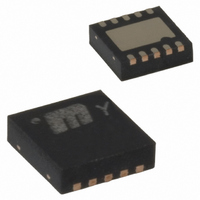MIC2202-1.5YML Micrel Inc, MIC2202-1.5YML Datasheet - Page 8

MIC2202-1.5YML
Manufacturer Part Number
MIC2202-1.5YML
Description
IC REG PWM SYNC 2MHZ 1.5V 10-MLF
Manufacturer
Micrel Inc
Type
Step-Down (Buck)r
Datasheet
1.MIC2202YMM.pdf
(19 pages)
Specifications of MIC2202-1.5YML
Internal Switch(s)
Yes
Synchronous Rectifier
No
Number Of Outputs
1
Voltage - Output
1.5V
Current - Output
600mA
Frequency - Switching
2MHz
Voltage - Input
2.3 ~ 5.5 V
Operating Temperature
-40°C ~ 125°C
Mounting Type
Surface Mount
Package / Case
10-MLF®, QFN
Lead Free Status / RoHS Status
Lead free / RoHS Compliant
Power - Output
-
The shaded region, 200mA to 500mA, efficiency loss is
dominated by MOSFET RDS
Higher input supply voltages will increase the Gate-to-
Source threshold on the internal MOSFETs, reducing the
internal RDS
DC losses in the device. All but the inductor losses are
inherent to the device. In which case, inductor selection
becomes increasingly critical in efficiency calculations.
As the inductors are reduced in size, the DC resistance
(DCR) can become quite significant. The DCR losses
can be calculated as follows;
From that, the loss in efficiency due to inductor
resistance can be calculated as follows:
Efficiency Loss =
Efficiency loss due to DCR is minimal at light loads and
gains significance as the load is increased. Inductor
selection becomes a trade-off between efficiency and
size in this case.
Alternatively, under lighter loads, the ripple current due
to the inductance becomes a significant factor. When
light load efficiencies become more critical, a larger
inductor value maybe desired. Larger inductances
reduce the peak-to-peak ripple current which minimize
losses. The following graph illustrates the effects of
inductance value at light load.
Compensation
The MIC2202 is an internally compensated, voltage
mode buck regulator. Voltage mode is achieved by
creating an internal 2MHz ramp signal and using the
output of the error amplifier to pulse width modulate the
switch node, maintaining output voltage regulation. With
a typical gain bandwidth of 200kHz, the MIC2202 is
capable of extremely fast transient responses.
The MIC2202 is designed to be stable with a 2.2µH
inductor and a 1µF ceramic (X5R) output capacitor.
Micrel, Inc.
March 2007
LPD = IOUT2 × DCR
Figure 3. Efficiency vs. Inductance
(ON)
100
. This improves efficiency by reducing
80
60
40
20
0
⎡
⎢
⎢
⎣
0
1
4.7µH
−
OUTPUT CURRENT (mA)
⎛
⎜
⎜
⎝
V
vs. Inductance
25
OUT
Efficiency
2.2µH
V
OUT
(ON)
×
50
I
OUT
×
and inductor DC losses.
I
1µH
1.8V
OUT
75
+
L
OUT
PD
100
⎞
⎟
⎟
⎠
⎤
⎥
⎥
⎦
×
100
8
These values can be interchanged (i.e. 1µH inductor and
a 2.2µF capacitor). The trade off between changing
these values is that with a larger inductor, there is a
reduced peak-to-peak current which yields a greater
efficiency at lighter loads. A larger output capacitor will
improve transient response by providing a larger hold up
reservoir of energy to the output.
Feedback
The MIC2202 provides a feedback pin to adjust the
output voltage to the desired level. This pin connects
internally to an error amplifier. The error amplifier then
compares the voltage at the feedback to the internal
0.5V reference voltage and adjusts the output voltage to
maintain regulation. To calculate the resistor divider
network for the desired output is as follows:
Where V
voltage. A 10kΩ or lower resistor value from the output
to the feedback is recommended. Larger resistor values
require an additional capacitor (feed-forward) from the
output to the feedback. The large high side resistor value
and the parasitic capacitance on the feedback pin
(~10pF) can cause an additional pole in the loop. The
additional pole can create a phase loss at high
frequency. This phase loss degrades transient response
by
capacitance negates the parasitic capacitive effects of
the feedback pin. A minimum 1000pF capacitor is
recommended for feed-forward capacitance.
Also, large feedback resistor values increase the
impedance, making the feedback node more susceptible
to noise pick-up. A feed-forward capacitor would also
reduce noise pick-up by providing a low impedance path
to the output.
PWM Operation
The MIC2202 is a pulse width modulation (PWM)
controller. By controlling the ratio of on-to-off time, or
duty cycle, a regulated DC output voltage is achieved.
As load or supply voltage changes, so does the duty
cycle to maintain a constant output voltage. In cases
where the input supply runs into a dropout condition, the
MIC2202 will run at 100% duty cycle.
The MIC2202 provides constant switching at 2MHz with
synchronous internal MOSFETs. The internal MOSFETs
include a high-side P-Channel MOSFET from the input
supply to the switch pin and an N-Channel MOSFET
from the switch pin to ground. Since the low-side N-
Channel MOSFET provides the current during the off
cycle, a free wheeling Schottky diode from the switch
node to ground is not required.
reducing
R2
REF
=
is 0.5V and V
⎛
⎜ ⎜
⎝
V
V
phase
OUT
REF
R1
−
1
⎞
⎟ ⎟
⎠
margin.
OUT
is the desired output
Adding
M9999-031907
feed-forward
MIC2202













